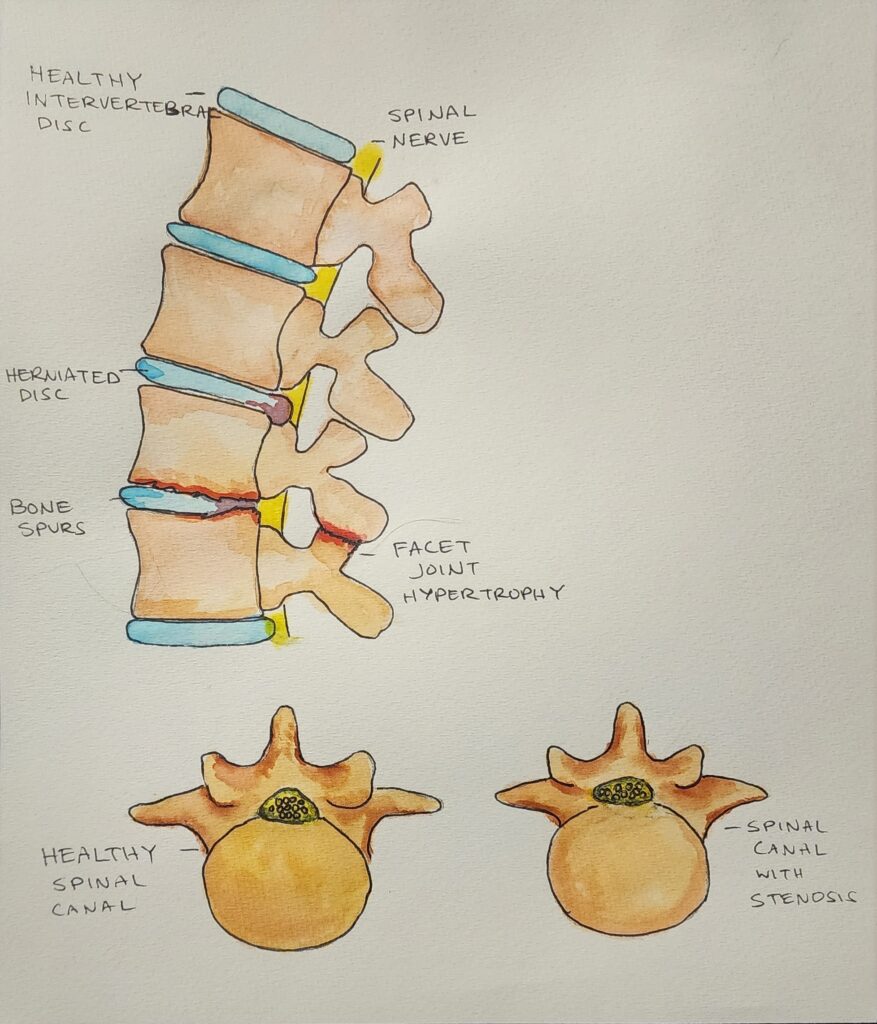
My objective is to elaborate on spondylosis which relates to the joint learning objective. My art piece is a watercolor painting of the spine with a depiction of a healthy joint and a selection of causes of spondylosis.
Spondylosis is a medical term derived from the Ancient Greek words “spondylo” meaning vertebrae and “osis” meaning condition or disease(7,11). Spondylosis, a spine condition, is a general term used to describe symptoms of spinal degeneration but does not diagnose the cause of degeneration. Deterioration of the spine happens in the intervertebral discs that are made of cartilage, the annulus fibrosus, and the gelatinous core, the nucleus pulposus(12). Discs are located between the vertebrae and function to support the spinal structure, provide cushioning which allows for flexibility, and protect nerves that run through the spine. Damage to the discs is ordinarily seen in the cervical and lumbar regions as opposed to the thoracic region of the spine due to the high mobility in those areas(4). These conditions are common in older individuals because of the natural wear and tear on the joints as we age but may also be caused by previous trauma to the area(16).
Degenerative disc disease (DDD) is a condition caused by worn discs, but typically no pain is associated with having it(1). This happens naturally with age as the nucleus pulposus dries out and becomes less cushiony, but discs can also tear because of an injury or strenuous activity(2). A tear in the annulus fibrosus can allow for a part of the nucleus pulposus to bulge out and put pressure on the nerves called a herniated disc(3). DDD can lead to arthritis which is associated with symptoms of pain and stiffness in the joint(14). Osteoarthritis is a degenerative disorder of the joints, where the tissues of the affected joint break down in areas such as the cartilage, ligaments, and bone. Discs that are affected by thinning can cause the bones of the vertebrae to rub together as the joint moves causing irritation(1) which can lead to osteophytes or bone spurs to develop which can cause spinal stenosis, a narrowing of the spinal nerve canal that impinges on nerves(6). The enlargement of the facet joint, the bony protrusion at the back vertebrae, can lead to facet joint hypertrophy which can cause limited mobility and pain(8,10).
My simply drawn watercolor painting is a labeled piece that depicts a section of the spine. In the painting, you can see what a healthy intervertebral disc and facet joint looks like. I show how a herniated disc can protrude from its original position and cause pressure on the nerve area. The next issue is a disc that has severely deteriorated and is no longer providing cushioning between the vertebrae. This caused the bones to grind against each other and develop bone spurs. Bone spurs also developed at the facet joint because of disc deterioration causing facet joint hypertrophy. I also showed the nerve canal of a healthy spine versus the narrowed canal of spinal stenosis. I found while researching spondylosis that there are many generalized terms and the causal relationship between joints makes diagnosing spine conditions difficult.
Citations
(1)Are degenerative disc disease and arthritis the same thing?. Saratoga Spine. (2021, January 22). https://saratogaspine.com/are-degenerative-disc-disease-and-arthritis-the-same/#:~:text=DDD%20can%20cause%20spinal%20osteoarthritis,pinched%20nerve%20in%20the%20neck.
(2)Degenerative disc disease. Degenerative Disc Disease | Arthritis Foundation. (n.d.). https://www.arthritis.org/diseases/degenerative-disc-disease
(3)Herniated disc. AANS. (n.d.). https://www.aans.org/Patients/Neurosurgical-Conditions-and-Treatments/Herniated-Disc#:~:text=A%20herniated%20disc%20(also%20called,an%20early%20stage%20of%20degeneration.
(4)Khormaee, S. (n.d.). Lumbar and cervical spondylosis: Symptoms & treatments: HSS. Hospital for Special Surgery. https://www.hss.edu/conditions_spondylosis-overview.asp
(5)Magill, S. (n.d.). Osteoarthritis. AANS. https://www.aans.org/en/Patients/Neurosurgical-Conditions-and-Treatments/Osteoarthritis
(6)Middleton, K., Fish, D.E. Lumbar spondylosis: clinical presentation and treatment approaches. Curr Rev Musculoskelet Med 2, 94–104 (2009). https://doi.org/10.1007/s12178-009-9051-x
(7)Osis:. Etymology. (n.d.). https://www.etymonline.com/search?q=osis
(8)Overcoming pain from facet joint syndrome. Spine One | Denver Spine Pain Specialists. (2020, April 22). https://spineone.com/facet-joint-syndrome-pain/
(9)Parker, L. (2020, July 24). Facet joint disorders and back pain. Spine. https://www.spine-health.com/conditions/arthritis/facet-joint-disorders-and-back-pain
(10)Seabright, J. (2022, September 12). Facet hypertrophy. Rheumatology Advisor. https://www.rheumatologyadvisor.com/ddi/facet-hypertrophy/
(11)Spondylo-. Etymology. (n.d.). https://www.etymonline.com/word/spondylo-
(12)Thomas, N. W. (2004). Low-back pain, sciatica, cervical and lumbar spondylosis. Surgery (Oxford), 22(2), 25–28. https://doi.org/10.1383/surg.22.2.25.27928
(13)Urban, J. P., & Roberts, S. (2003, March 11). Degeneration of the intervertebral disc. Arthritis research & therapy. https://www.ncbi.nlm.nih.gov/pmc/articles/PMC165040/#:~:text=The%20intervertebral%20discs%20are%20complex,superiorly%20by%20cartilage%20end%2Dplates.
(14)U.S. Department of Health and Human Services. (2023, September 29). Niams health information on osteoarthritis. National Institute of Arthritis and Musculoskeletal and Skin Diseases. https://www.niams.nih.gov/health-topics/osteoarthritis
(15)U.S. Department of Health and Human Services. (2023b, November 16). Spinal Stenosis. National Institute of Arthritis and Musculoskeletal and Skin Diseases. https://www.niams.nih.gov/health-topics/spinal-stenosis
(16)Yale Medicine. (2022, November 2). Spondylosis. Yale Medicine. https://www.yalemedicine.org/conditions/spondylosis#:~:text=The%20most%20common%20cause%20of,previous%20trauma%20to%20the%20spine.

Crystal Rolig’s STEAM project explained spondylosis, expanding upon the learning objective of joints. Spondylosis is the term used to describe conditions of spinal degeneration, regardless of the underlying cause. This degeneration is specifically of the intervertebral discs and may be a result of past trauma or simply the normal wear and tear that accompanies old age. The discs provide cushioning between the vertebrae, allow for flexibility of the spine, and protect spinal nerves. Spondylosis can cause interference with nerves, limited mobility, and pain.
I understood her write-up very well; it was concise and well-researched, and the writing had a logical structure. There were a few terms that I would have appreciated a brief definition of, however, and I was also a little confused by the introduction of degenerative disc disease (DDD). Although the relevance of DDD to spondylosis was clear, Rolig did not explain their relationship. I was left a little lost as to whether DDD is a type of spondylosis, a co-occurring condition, or something else.
I found the art to be very impressive. More labels identifying the relevant features of the art and the specific places affected by the condition would have been helpful, but it was nevertheless easy to understand. It was very literal, but this conveyed the idea well.